Effect of Decreasing Temperature Reciprocating Upsetting-Extrusion on Microstructure and Mechanical Properties of Mg-Gd-Y-Zr Alloy
Abstract
1. Introduction
2. Materials and Methods
3. Results and Discussion
3.1. Microstructure Evolution of the RUE Alloys
3.2. Texture Evolution of the RUE Alloys
3.3. Mechanical Properties of the RUE Alloys
4. Conclusions
- (1)
- The alloy exhibits a typical bimodal structure in the RUE process. The grains are gradually refined, and after four passes of deformations, the average grain size reaches 6.72 μm.
- (2)
- After four passes of RUE deformation, the alloy is principally consisted of α-Mg matrix phase and Mg5 (Gd, Y) phase. A large number of Mg5 (Gd, Y) phase precipitated along the DRX grain boundary, and the PSN accelerates the formation of DRX.
- (3)
- As the RUE experiment proceeds, the basal texture intensity decreases, which is due to the DRX grains, diffused Mg5 (Gd, Y) phase and the alternating axial and radial transformation of the loading direction during the deformation process. The basal strength distribution is scattered. Most (0001) bases are deflected toward the direction of the squeeze.
- (4)
- After 4 RUE passes, the alloy has excellent mechanical properties, UTS is 320 ± 3.2 MPa, TYS is 258 ± 2.6 MPa, and the elongation is 11.7 ± 0.1%, which is the result of dislocation strengthening, grain refinement, and Mg5 (Gd, Y) phase dispersed distribution.
Author Contributions
Funding
Conflicts of Interest
References
- Yan, Z.M.; Fang, M.; Lian, Z.D.; Zhang, Z.M.; Zhu, J.X.; Zhang, G.S.; Wang, Y.D. Research on AZ80 + 0.4%Ce (wt %) Ultra-Thin-Walled Tubes of Magnesium Alloys: The Forming Process, Microstructure Evolution and Mechanical Properties. Metals 2019, 9, 563. [Google Scholar] [CrossRef]
- Dong, B.B.; Zhang, Z.M.; Che, X.; Yu, J.M.; Meng, M.; Zhang, J.L. Microstructure, Texture Evolution, and Mechanical Properties of MDFed GWZ Alloy Containing LPSO Phases on the Condition of High and Low Temperature Cycle Deformation. Metals 2020, 10, 136. [Google Scholar] [CrossRef]
- Zhang, G.; Zhang, Z.; Du, Y.; Yan, Z.; Che, X. Effect of Isothermal Repetitive Upsetting Extrusion on the Microstructure of Mg-12.0Gd-4.5Y-2.0Zn-0.4Zr Alloy. Materials 2018, 11, 2092. [Google Scholar] [CrossRef] [PubMed]
- Wang, L.; Zhao, Y.Q.; Chen, H.M.; Zhang, J.; Liu, Y.D.; Wang, Y.N. Improvement of Mechanical Properties of Magnesium Alloy ZK60 by Asymmetric Reduction Rolling. Acta Metall. Sin. 2017, 31, 63–70. [Google Scholar] [CrossRef]
- Xia, X.; Zhang, K.; Li, X.; Ma, M.; Li, Y. Microstructure and texture of coarse-grained Mg-d-Y-Nd–Zr alloy after hot compression. Mater. Des. 2013, 44, 521–527. [Google Scholar] [CrossRef]
- Du, B.N.; Hu, Z.Y.; Sheng, L.Y.; Xu, D.K.; Zheng, Y.F.; Xi, T.F. Influence of Zn Content on Microstructure and Tensile Properties of Mg-Zn-Y-Nd Alloy. Acta Metall. Sin. 2018, 31, 351–361. [Google Scholar] [CrossRef]
- Maier, P.; Peters, R.; Mendis, C.L.; Müller, S.; Hort, N. Influence of Precipitation Hardening in Mg-Y-Nd on Mechanical and Corrosion Properties. JOM 2015, 68, 1183–1190. [Google Scholar] [CrossRef]
- Zhang, K.; Ma, M.L.; Li, X.G.; Li, Y.J.; Liang, L.C.; Bing, M.F. Hot deformation behavior of Mg-7.22Gd-4.84Y-1.26Nd-0.58Zr magnesium alloy. Rare Met. 2011, 30, 87–93. [Google Scholar] [CrossRef]
- Hebesberger, T.; Stuewe, H.P.; Vorhauer, A.; Wetscher, F.; Pippan, R. Structure of Cu deformed by high pressure torsion. Acta Mater. 2005, 53, 393–402. [Google Scholar] [CrossRef]
- Yamasaki, M.; Hashimoto, K.; Hagihara, K.; Kawamura, Y. Effect of multimodal microstructure evolution on mechanical properties of Mg-Zn-Y extruded alloy. Acta Mater. 2011, 59, 3646–3658. [Google Scholar] [CrossRef]
- Chen, T.; Chen, Z.Y.; Shao, J.B.; Wang, R.K.; Mao, L.H.; Liu, C.M. Evolution of LPSO phases in a Mg-Zn-Y-Gd-Zr alloy during semi-continuous casting, homogenization and hot extrusion. Mater. Des. 2018, 152, 1–9. [Google Scholar] [CrossRef]
- Jana, A.; Das, M.; Balla, V.K. Effect of heat treatment on microstructure, mechanical, corrosion and biocompatibility properties of Mg-Zn-Zr-Gd-Nd alloy. J. Alloys Compd. 2019, 821, 153462. [Google Scholar] [CrossRef]
- Liu, H.; Huang, H.; Yang, X.W.; Li, C.; Yan, J.L.; Jiang, J.H.; Ma, A.B. Microstructure and mechanical property of a high-strength Mg-10Gd-6Y-1.5Zn-0.5Zr alloy prepared by multi-pass equal channel angular pressing. J. Magnes. Alloy. 2017, 5, 231–237. [Google Scholar] [CrossRef]
- Gao, J.H.; Guan, S.K.; Ren, Z.W.; Sun, Y.F.; Zhu, S.J.; Wang, B. Homogeneous corrosion of high pressure torsion treated Mg-Zn-Ca alloy in simulated body fluid. Mater. Lett. 2010, 65, 691–693. [Google Scholar] [CrossRef]
- Xia, X.; Chen, Q.; Zhao, Z.; Ma, M.; Li, X.; Zhang, K. Microstructure, texture and mechanical properties of coarse-grained Mg–Gd–Y–Nd–Zr alloy processed by multidirectional forging. J. Alloys Compd. 2015, 623, 62–68. [Google Scholar] [CrossRef]
- Lin, J.; Wang, X.; Ren, W.; Yang, X.; Wang, Q. Enhanced Strength and Ductility Due to Microstructure Refinement and Texture Weakening of the GW102K Alloy by Cyclic Extrusion Compression. J. Mater. Sci. Technol. 2016, 32, 783–789. [Google Scholar] [CrossRef]
- Tatsuhiko, A.; Kazuto, T. Bulk Mechanical Alloying for Productive Processing of Functional Alloys. Mater. Sci. Forum 1999, 312–314, 13–22. [Google Scholar]
- Chen, Q.; Zhao, Z.D.; Zhao, Z.X.; Hu, C.K.; Shu, D.Y. Microstructure development and thixoextrusion of magnesium alloy prepared by repetitive upsetting-extrusion. J. Alloys Compd. 2011, 509, 7303–7315. [Google Scholar] [CrossRef]
- Xu, Y.; Hu, L.-x.; Sun, Y.; Jia, J.-b.; Jiang, J.-f.; Ma, Q.-g. Microstructure and mechanical properties of AZ61 magnesium alloy prepared by repetitive upsetting-extrusion. Trans. Nonferrous Met. Soc. China 2015, 25, 381–388. [Google Scholar] [CrossRef]
- Xu, Y.; Chen, C.; Jia, J.B.; Zhang, X.X.; Dai, H.H.; Yang, Y. Constitutive behavior of a SIMA processed magnesium alloy by employing repetitive upsetting-extrusion (RUE). J. Alloys Compd. 2018, 748, 694–705. [Google Scholar] [CrossRef]
- Cui, Y.; Zhang, Z.M.; Zhang, B.H.; Yu, J.M.; Wang, Q. Effect of Multiple Plastic Deformation on Microstructure and Mechanical Properties of 7A04 Ultra-High Strength Aluminum Alloy. Steel Res. Int. 2010, 81, 442–445. [Google Scholar]
- Du, Y.; Zhang, Z.M.; Zhang, G.S.; Yu, J.M. Grain Refinement and Texture Evolution of Mg-Gd-Y-Zn-Zr Alloy Processed by Repetitive Usetting-Extrusion at Decreasing Temperature. Rare Met. Mater. Eng. 2018, 47, 1422–1428. [Google Scholar]
- Zhang, G.S.; Meng, Y.Z.; Yan, F.F.; Gao, Z.; Yan, Z.M.; Zhang, Z.M. Microstructure and texture evolution of Mg-RE-Zn alloy prepared by repetitive upsetting-extrusion under different decreasing temperature degrees. J. Alloys Compd. 2020, 815, 152452. [Google Scholar] [CrossRef]
- Meng, Y.Z.; Yu, J.M.; Liu, K.; Yu, H.S.; Zhang, F.; Wu, Y.J.; Zhang, Z.M.; Luo, N.N.; Wang, H.H. The evolution of long-period stacking ordered phase and its effect on dynamic recrystallization in Mg-Gd-Y-Zn-Zr alloy processed by repetitive upsetting-extrusion. J. Alloys Compd. 2020, 828, 154454. [Google Scholar] [CrossRef]
- Wang, Q.D.; Chen, Y.J.; Liu, M.P.; Lin, J.B.; Roven, H.J. Microstructure evolution of AZ series magnesium alloys during cyclic extrusion compression. Mater. Sci. Eng. A 2010, 527, 2265–2273. [Google Scholar] [CrossRef]
- Liu, K.; Rokhlin, L.L.; Elkin, F.M.; Tang, D.X.; Meng, J. Effect of ageing treatment on the microstructures and mechanical properties of the extruded Mg–7Y–4Gd–1.5Zn–0.4Zr alloy. Mater. Sci. Eng. A 2010, 527, 828–834. [Google Scholar] [CrossRef]
- Robson, J.D.; Henry, D.T.; Davis, B. Particle effects on recrystallization in magnesium-manganese alloys: Particle-stimulated nucleation. Acta Mater. 2009, 57, 2739–2747. [Google Scholar] [CrossRef]
- Hagihara, K.; Yokotani, N.; Umakoshi, Y. Plastic deformation behavior of Mg12YZn with 18R long-period stacking ordered structure. Intermetallics 2010, 18, 267–276. [Google Scholar] [CrossRef]
- Yan, H.; Xu, S.W.; Chen, R.S.; Kamado, S.; Honma, T.; Han, E.H. Twins, shear bands and recrystallization of a Mg-2.0%Zn-0.8%Gd alloy during rolling. Scr. Mater. 2011, 64, 141–144. [Google Scholar] [CrossRef]
- Zhang, Y.; Zeng, X.Q.; Lu, C.; Ding, W.J. Deformation behavior and dynamic recrystallization of a Mg–Zn–Y–Zr alloy. Mater. Sci. Eng. A 2006, 428, 91–97. [Google Scholar] [CrossRef]
- Vogel, M.; Kraft, O.; Dehm, G.; Arzt, E. Quasi-crystalline grain-boundary phase in the magnesium die-cast alloy ZA85. Scr. Mater. 2001, 45, 517–524. [Google Scholar] [CrossRef]
- Wang, Y.N.; Huang, J.C. Texture analysis in hexagonal materials. Mater. Chem. Phys. 2003, 81, 11–26. [Google Scholar] [CrossRef]
- Prez-Prado, M.T.; del Valle, J.A.; Ruano, O.A. Effect of sheet thickness on the microstructural evolution of an Mg AZ61 alloy during large strain hot rolling. Scr. Mater. 2004, 50, 667–671. [Google Scholar] [CrossRef]
- Yang, P. Experimental determination and theoretical prediction of twin orientation in magnesium alloy AZ31. Scr. Mater. 2004, 50, 1163–1168. [Google Scholar] [CrossRef]
- Kalidindi, S.R. Incorporation of deformation twinning in crystal plasticity models. J. Mech. Phys. Solids 1998, 46, 267–290. [Google Scholar] [CrossRef]
- Wihelm, M. Magnesium Alloys and their Applications. Mater. Technol. 1998, 13, 121–122. [Google Scholar]
- Mukai, T.; Watanabe, H.; Ishikawa, K.; Higashi, K. Guide for Enhancement of Room Temperature Ductility in Mg Alloys at High Strain Rates. Mater. Sci. Forum 2003, 419–422, 171–176. [Google Scholar] [CrossRef]
- Lin, J.B.; Wang, Q.D.; Chen, Y.X.; Cui, X.C. Influence of Grain Refinement and Texture Evolution on the Yield Strength of Mg Alloy Processed by Cyclic Extrusion and Compression. Mater. Trans. 2014, 55, 120–122. [Google Scholar] [CrossRef]
- Yu, H.H.; Xin, Y.C.; Wang, M.Y. Hall-Petch relationship in Mg alloys: A review. J. Mater. Sci. Technol. 2018, 34, 248–256. [Google Scholar] [CrossRef]
- Zhang, Z.M.; Du, Y.; Zhang, G.S.; Yan, Z.M.; Yu, J.M.; Meng, M. Microstructure and Mechanical Properties of Mg–Gd–Y–Zn–Zr Alloy Prepared by Repetitive Upsetting and Extrusion. Mater. Trans. 2018, 59, 669–673. [Google Scholar] [CrossRef]
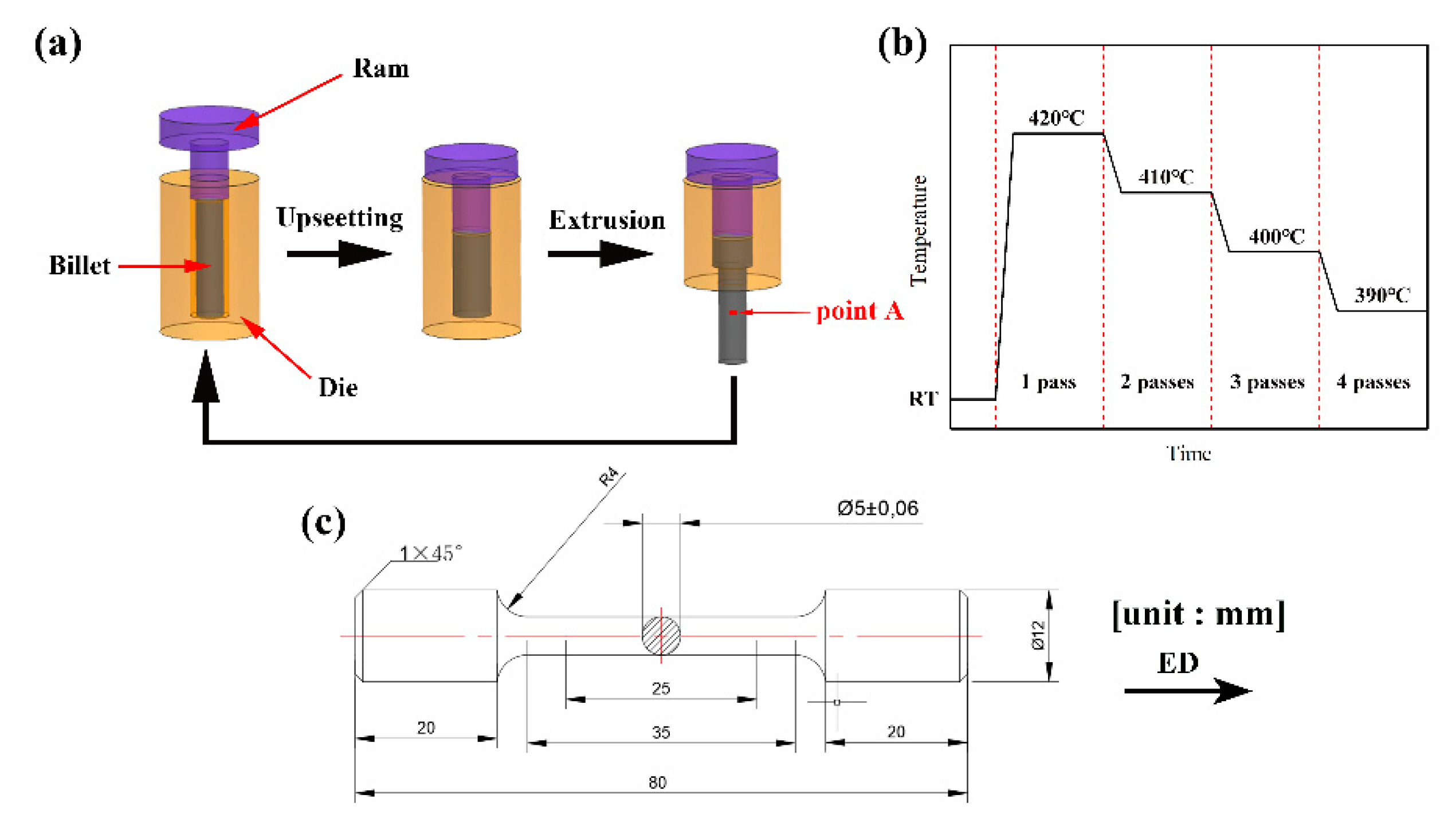
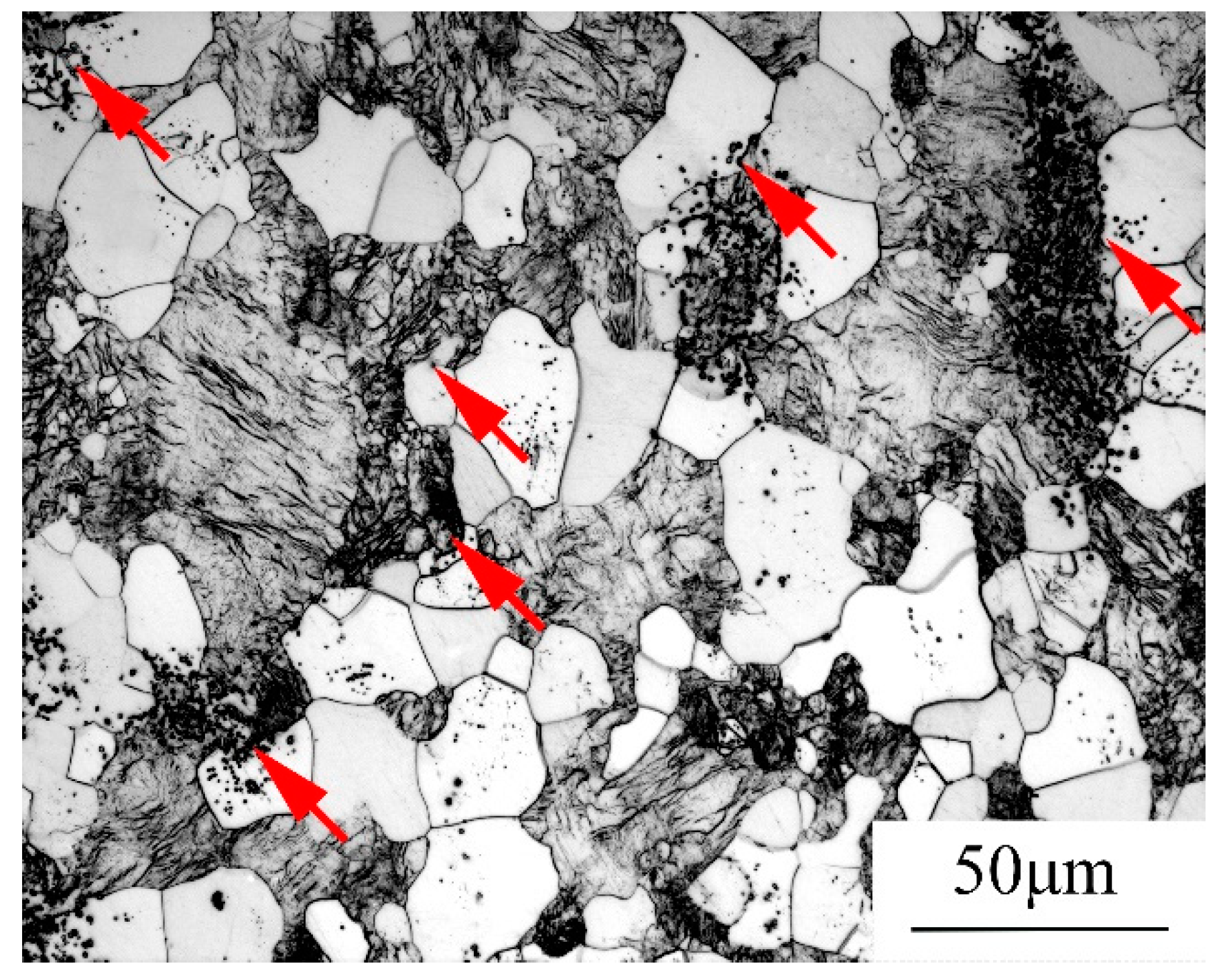
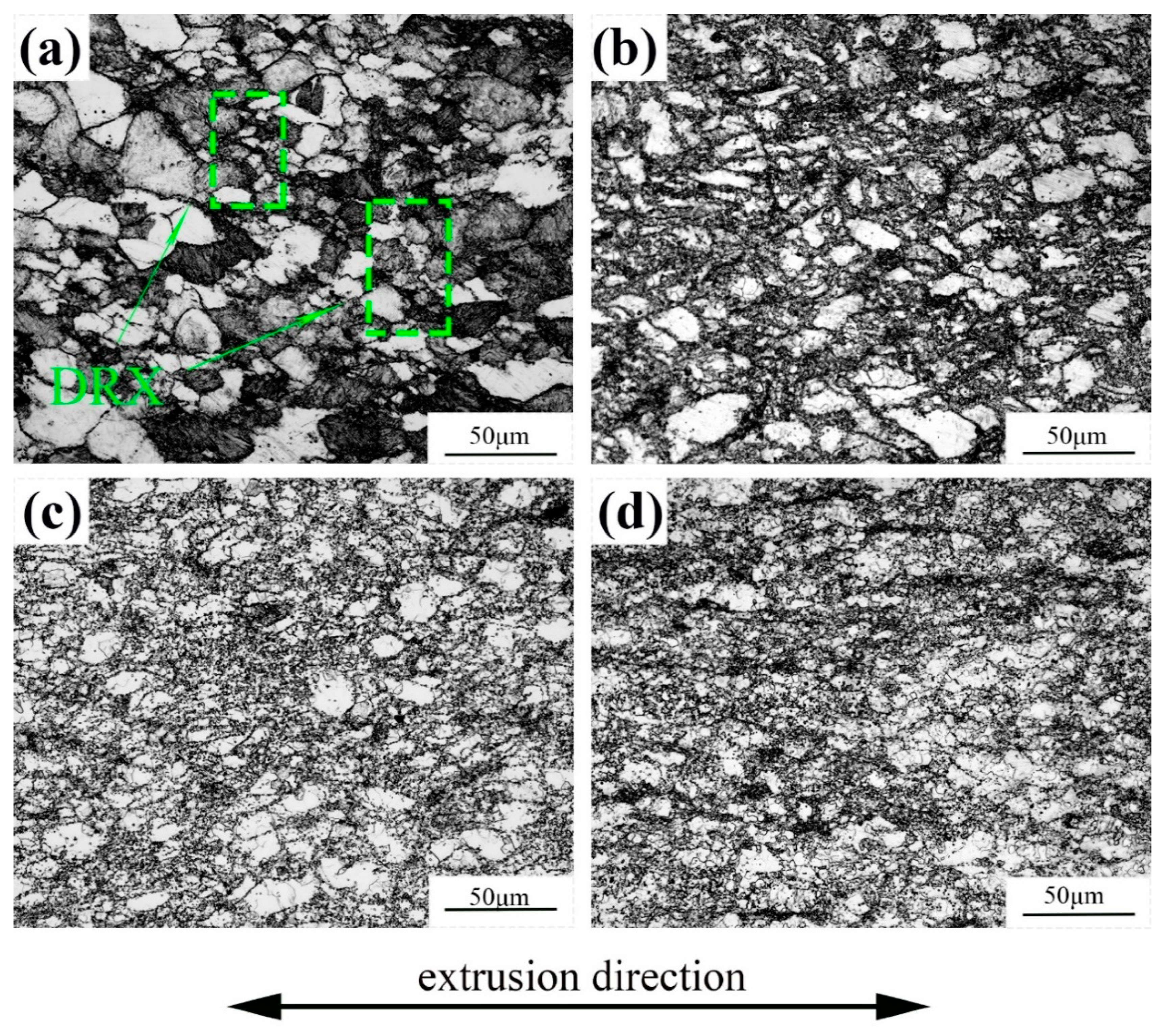
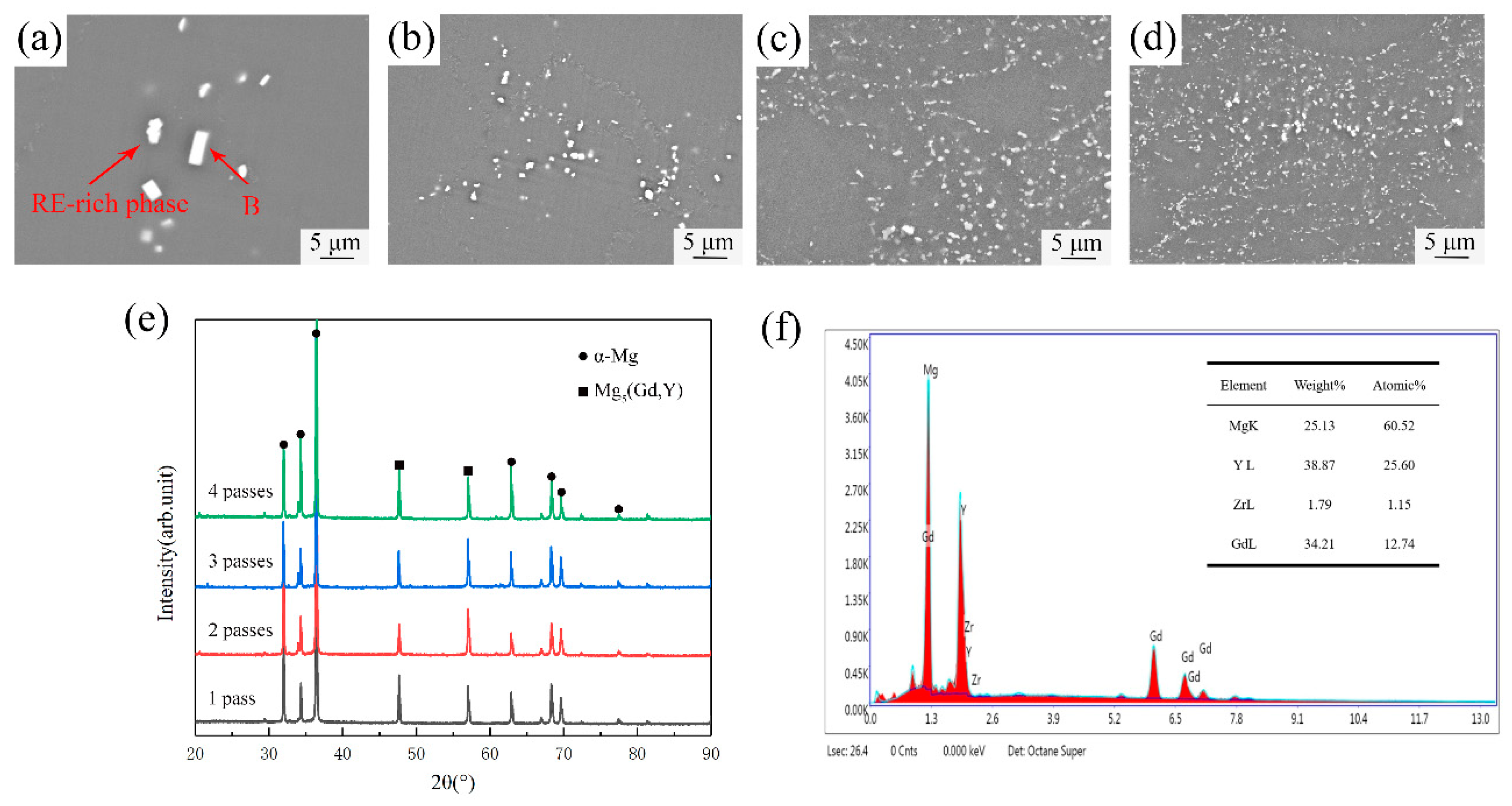
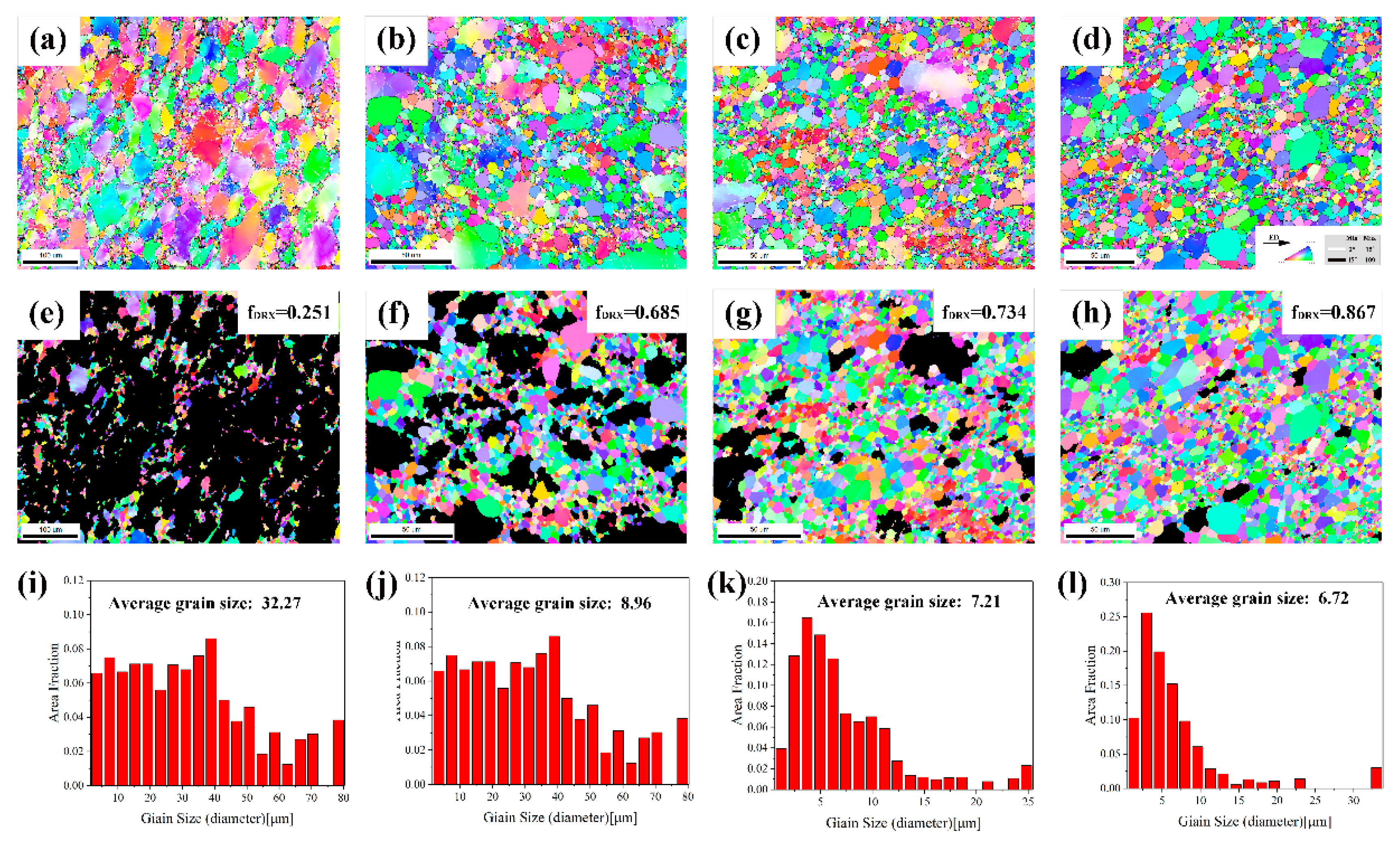
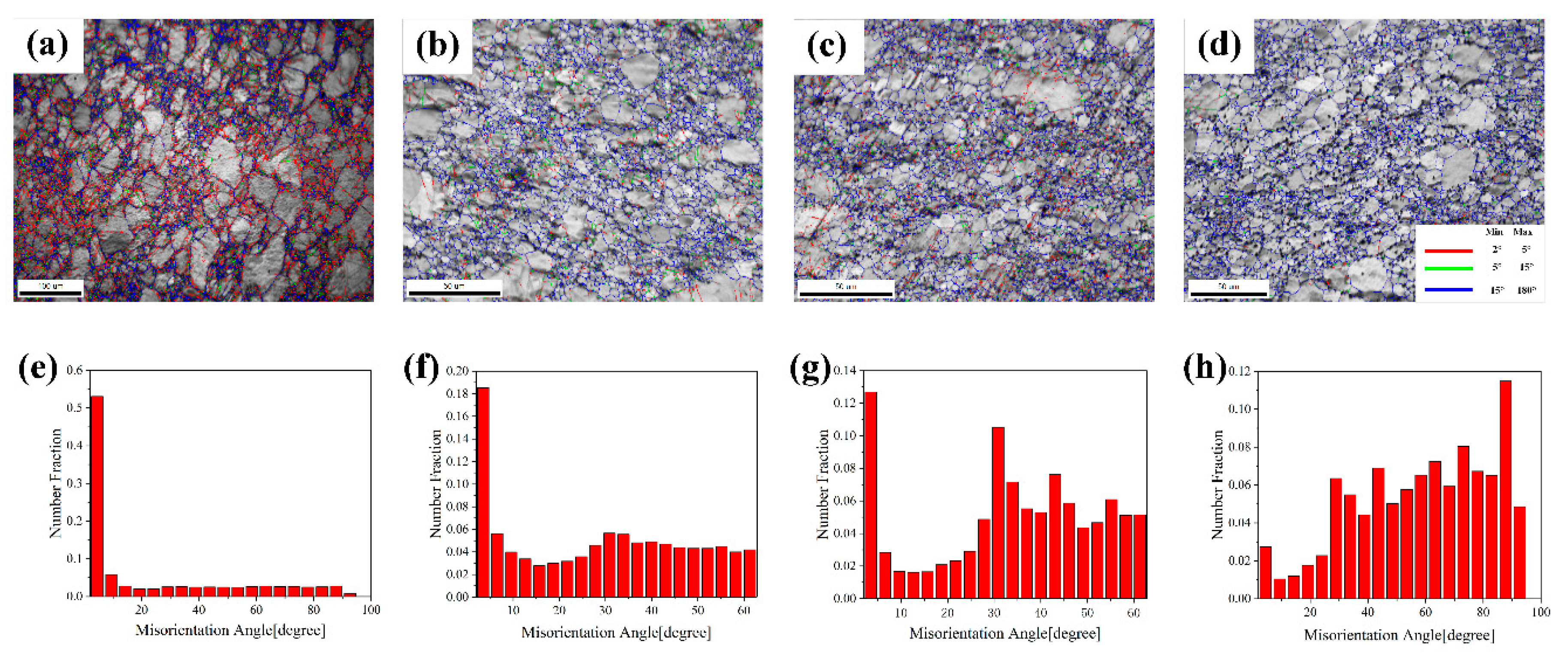
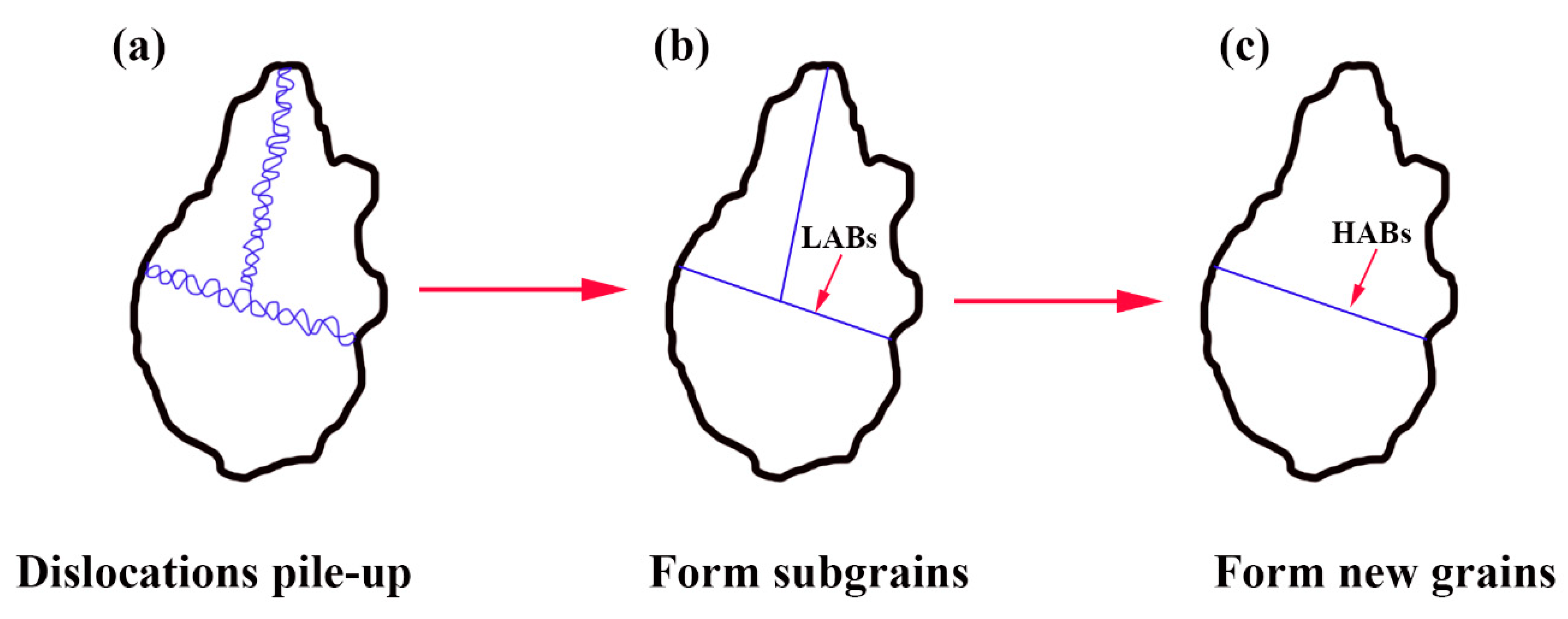
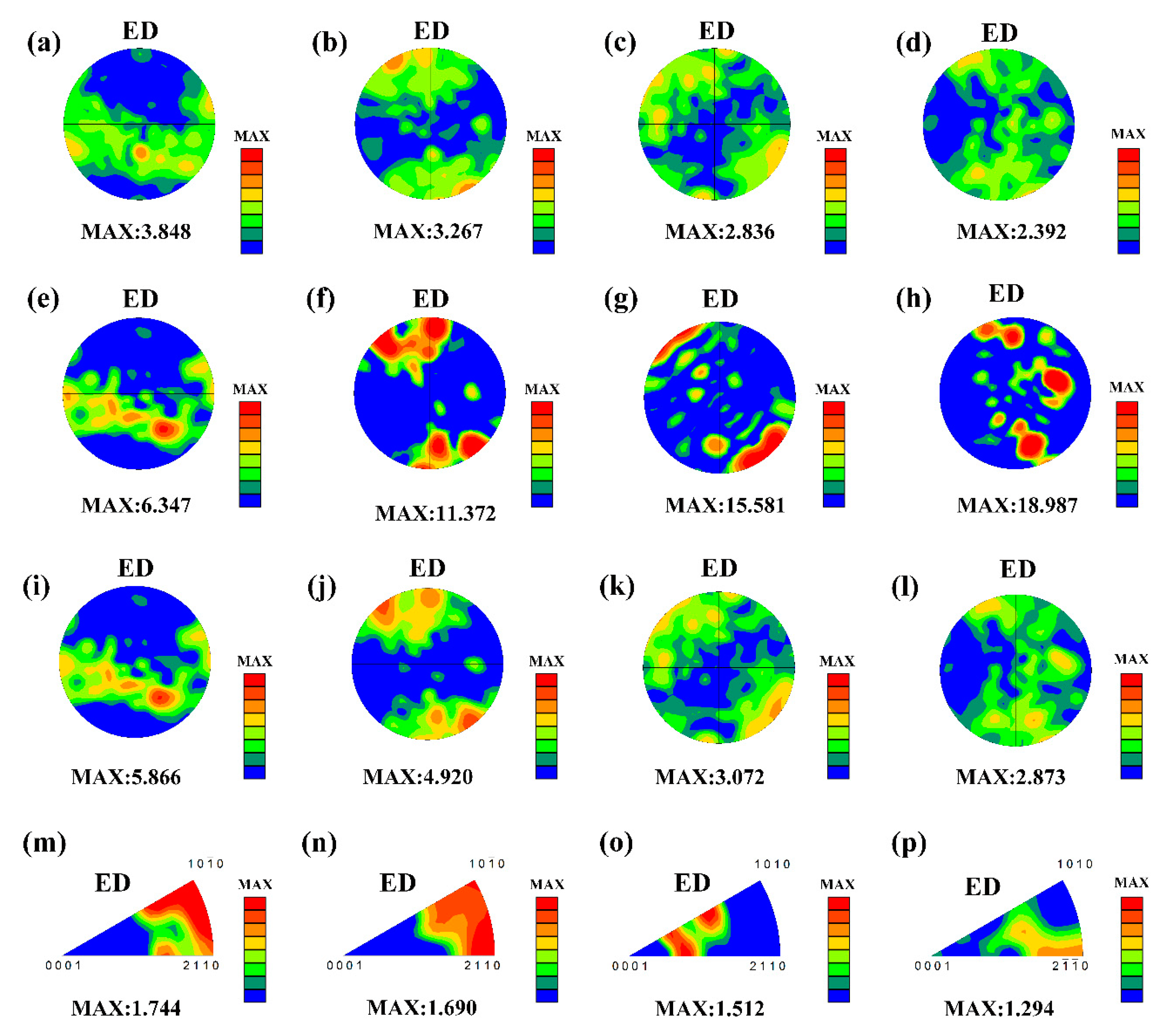
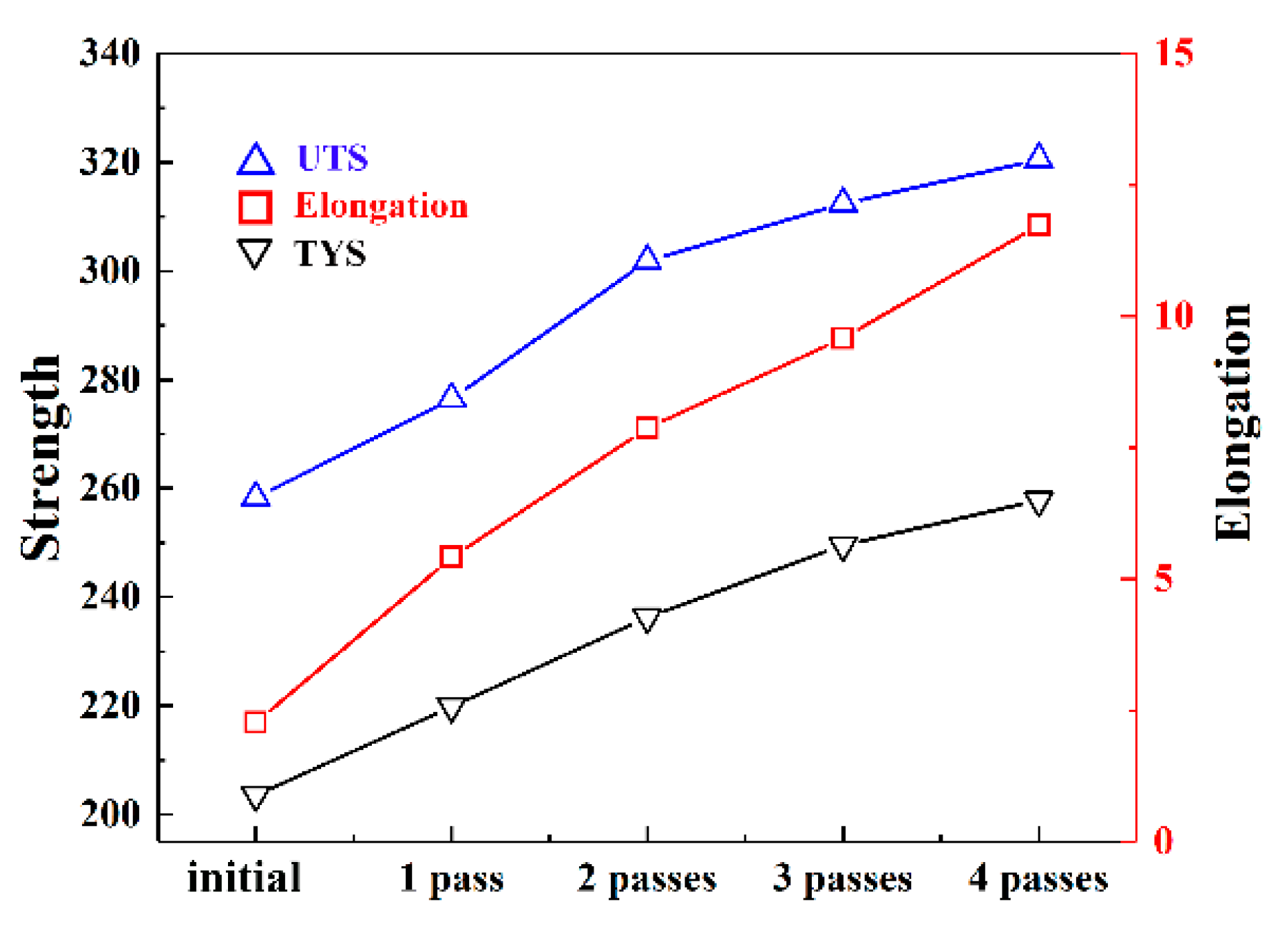
© 2020 by the authors. Licensee MDPI, Basel, Switzerland. This article is an open access article distributed under the terms and conditions of the Creative Commons Attribution (CC BY) license (http://creativecommons.org/licenses/by/4.0/).
Share and Cite
Xu, W.; Yu, J.; Wu, G.; Jia, L.; Gao, Z.; Miao, Z.; Zhang, Z.; Yan, F. Effect of Decreasing Temperature Reciprocating Upsetting-Extrusion on Microstructure and Mechanical Properties of Mg-Gd-Y-Zr Alloy. Metals 2020, 10, 985. https://doi.org/10.3390/met10070985
Xu W, Yu J, Wu G, Jia L, Gao Z, Miao Z, Zhang Z, Yan F. Effect of Decreasing Temperature Reciprocating Upsetting-Extrusion on Microstructure and Mechanical Properties of Mg-Gd-Y-Zr Alloy. Metals. 2020; 10(7):985. https://doi.org/10.3390/met10070985
Chicago/Turabian StyleXu, Wenlong, Jianmin Yu, Guoqin Wu, Leichen Jia, Zhi Gao, Zhan Miao, Zhimin Zhang, and Feng Yan. 2020. "Effect of Decreasing Temperature Reciprocating Upsetting-Extrusion on Microstructure and Mechanical Properties of Mg-Gd-Y-Zr Alloy" Metals 10, no. 7: 985. https://doi.org/10.3390/met10070985
APA StyleXu, W., Yu, J., Wu, G., Jia, L., Gao, Z., Miao, Z., Zhang, Z., & Yan, F. (2020). Effect of Decreasing Temperature Reciprocating Upsetting-Extrusion on Microstructure and Mechanical Properties of Mg-Gd-Y-Zr Alloy. Metals, 10(7), 985. https://doi.org/10.3390/met10070985




